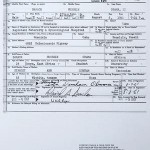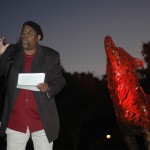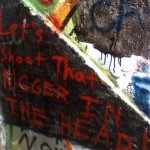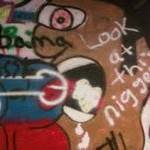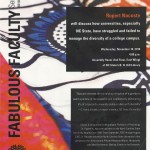Like I said (see “Another Racial Graffiti Storm†April 12, 2011), at the end of the busiest semester of my twenty-three -year career as a professor (Fall 2010), something new and important was starting. When I returned to campus for the Spring-2011 semester, that something new and important was waiting for me.Â
   I had promised to pull together a planning committee to keep the Wake Up! It’s Serious movement going. Taylor Elkins met with me to begin that task. We came up with names, and she sent an email out to those students. Nothing happened… and I realized that I had to give the weight of authority and commitment to this effort. I sent an email and seven out of eight students responded.Â
   Lo and behold we held our first meeting on January 22, 2011.
   To start that meeting, I asked each student to introduce themselves. Then I asked each to say something about “…why do you want to be part of the Wake Up! It’s Serious Movement?â€
   Taylor, a white female said she wanted to learn to be an advocate for diversity.
   Natalia, of Columbian heritage, talked about living in the international dormitory, and seeing the power of diversity.
   Hayat talked about her traditional Middle Eastern, Arab-American parents and growing up in Cary, NC, and the hurt of the jokes she heard after 9/11.
   Mario, an African American male, said that for him the idea of the movement was about moving himself and other people up through education.
   Komal, of Turkish-Indian descent, said that as a resident-advisor she had seen that when the Free Expression incident happened, no one on her hall wanted to talk about it. That disturbed her and motivated her to want to work for change.
   Melody, an African American female, said she had seen too much stubbornness among her college peers about addressing racial issue, and wants to be part of a movement for change.
   Christie, a white female, said she came from a small, mostly white town, where race was not discussed in any positive way. She said that she thought that it would be different in Raleigh, at N.C. State, but found the silence was even worse in a way. She wants to be part of a movement to get people talking about race.
   Brittany said, “I’m white as they come; no I’m really white.â€Â She went on to say that as a resident-advisor, when she talked about how much the racial graffiti and anti-gay slurs offended her and something needed to be done, students laughed and asked her “…why do you care?â€Â She wants people to come to understand that these kinds of things hurt us all.
   Sascha, a white male, of German-Jewish heritage, said, he wanted to be part of Wake Up because “…silence in the face of intolerance is worse than the intolerance itself.â€
   Why were they here, at this first meeting? In a word the answer was… passion. Passion for change, passion to do something about the neo-diversity problem of negative language and messages aimed at fellow students; fellow citizens of our campus. With that passion, focus, and good humor we had the neo-diverse core group we needed to get things going.
   In that first meeting, I introduced the goals of the committee; strategic planning. I know… that sounds so bland and typical. But our goal was to do strategic planning through action. Yes the first two meetings involved planning, but that was to set us up for action. I promised that we would develop concrete ideas for activities, with priorities, and that we would never meet for more than an hour and a half.Â
   With that, we immediately began to put together our mission/vision statement.

